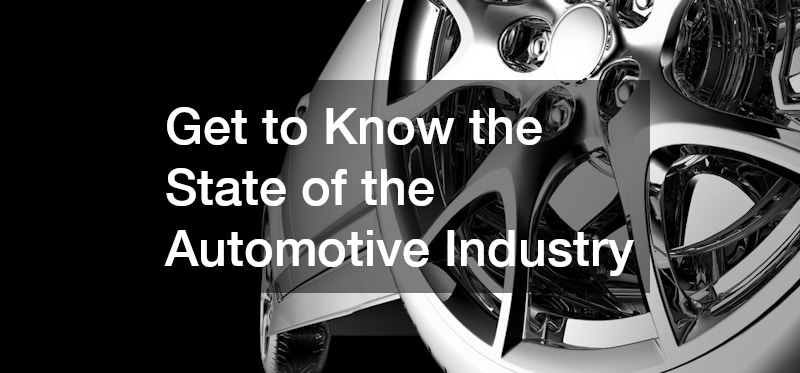The automotive industry today is experiencing a period of profound transformation driven by technological breakthroughs, shifting consumer expectations, and evolving regulatory landscapes. From traditional gasoline-powered vehicles to electrified and autonomous models, manufacturers are reinventing everything from assembly processes to service networks. Simultaneously, aftermarket providers and local garages face new challenges and opportunities, as vehicle complexity increases and digital platforms become integral to customer engagement. In this expansive overview, we’ll explore market dynamics, innovation trajectories, environmental imperatives, service trends, luxury and specialty segments, and the road ahead. Whether you’re a dealer, technician, or simply an enthusiast, understanding these forces will help you navigate an industry in motion.
Market Overview and Growth Drivers
Over the past decade, global vehicle sales have rebounded from economic downturns to exceed 90 million units annually. Emerging markets in Asia and Latin America are driving significant volume, while North America and Europe focus on premium segments and electrification. Consumer preferences continue shifting toward SUVs and crossovers, prompting automakers to realign production lines. Meanwhile, shared-mobility models and subscription programs challenge traditional ownership, as urban dwellers seek flexible access rather than long-term commitment. These trends influence dealership strategies, inventory planning, and the aftermarket ecosystem.
Independent operators—ranging from a neighborhood local auto repair shop to nationwide service chains—are adjusting to handle a wider array of technologies. They must equip technicians with tools and training for advanced driver-assistance systems, hybrid powertrains, and digital diagnostics. Investment in computerized service-management platforms and customer-relationship systems has risen sharply, enabling real-time appointment scheduling, service reminders, and personalized offers. These digital enhancements not only improve operational efficiency but also align with growing consumer demands for convenience and transparency.
As the market diversifies, service providers are expanding beyond traditional mechanical work. For instance, many now offer windshield tinting service to help customers manage cabin temperatures and protect interior materials from UV damage. Others integrate car detailing packages—such as exterior polish and interior deep cleaning—to deliver aesthetic and protective benefits in one appointment. By bundling these offerings, shops increase average repair orders and deepen customer relationships, which is critical when new-vehicle warranties still cover routine maintenance.
Technological Innovation and Vehicle Electrification
Electrification has emerged as one of the most disruptive forces in the automotive sector. Battery-electric vehicles (BEVs) and plug-in hybrids (PHEVs) now account for more than 10 percent of new-car registrations in leading markets. Automakers are racing to develop solid-state batteries, fast-charging networks, and vehicle-to-grid capabilities that enable cars to feed power back to the home or grid. These initiatives require substantial capital investment, but they promise lower operating costs and zero tailpipe emissions for end users.
Service facilities must adapt accordingly. High-voltage safety training is mandatory for technicians servicing BEVs, and repair bays need insulated mats, specialized lifting equipment, and isolation barriers to handle battery pack removal or replacement. Meanwhile, traditional brake services evolve with regenerative braking systems that reduce wear on friction brakes. Technicians must understand how to calibrate electronic modules and manage brake fluid changes in hybrid models. Even routine tasks—like replacing brake pads or flushing cooling systems—now involve new specifications and procedures unique to electrified platforms.
In parallel, software-defined vehicles are becoming the norm. Over-the-air (OTA) updates for infotainment systems, safety calibrations, and performance tweaks reduce the need for in-shop recalls. However, shops offering auto glass repair or crash-damage restoration must ensure that camera-based driver-assistance sensors behind windshields are recalibrated correctly after replacement. This adds complexity and underscores the importance of up-to-date diagnostic tools and manufacturer partnerships.
Regulatory and Environmental Imperatives
Stricter emissions standards worldwide are pushing manufacturers toward cleaner technologies and more efficient internal-combustion engines. In many regions, annual car emissions testing is mandatory to verify compliance with particulate- and nitrogen-oxide limits. Testing stations employ chassis dynamometers and infrared gas analyzers to simulate real-world driving, while mobile units allow inspections at remote locations. When vehicles fail, mechanics diagnose sensor faults, exhaust leaks, or catalyst degradation before retesting.
Beyond tailpipe regulations, governments incentivize fleet electrification through tax credits, low-emission zones, and corporate-average fuel-economy requirements. Automakers face hefty penalties if their fleet-wide averages exceed targeted thresholds, motivating rapid rollouts of electric and hybrid models. Dealers in high-demand areas now offer test drives of zero-emission vehicles alongside traditional gasoline trims. This regulatory environment not only shapes manufacturing priorities but also influences consumer expectations around sustainability.
Meanwhile, service providers play a crucial role in environmental compliance. Proper disposal or recycling of used engine oil, brake fluid, and battery acids is regulated to prevent soil and water contamination. Many local auto repair shops partner with certified recyclers to collect hazardous wastes and scrap metal. In doing so, they support circular-economy goals and reinforce their commitment to community health.
Service and Maintenance Trends
As vehicles grow more complex, routine maintenance evolves beyond oil changes and filter replacements. Full-service packages may include computer-based diagnostics, fluid flushes for transmission and cooling systems, and cabin-air-filter replacements for enhanced air quality. Consumers increasingly expect bundled auto detailing services that pair mechanical upkeep with interior cleaning, exterior washing, and protective coating applications. These comprehensive offerings streamline scheduling and provide one-stop convenience.
Brake services remain a cornerstone, given the critical safety role of braking systems. In addition to traditional pad and rotor replacements, shops now offer performance upgrades for enthusiasts—high-friction compounds and slotted rotors that resist fade under racing conditions. Technicians calibrate anti-lock braking systems (ABS) and electronic stability controls after part changes to ensure consistent stopping power. This level of precision requires specialized scan tools and adherence to manufacturer torque and bleed procedures.
Auto glass repair has also seen innovation. Simple chip repairs can be completed in minutes using injected resins that restore structural integrity and optical clarity. For more severe damage, full windshield replacements employ bonding adhesives that meet original strength specs. Because many modern windshields house sensors and cameras for lane-keep assist, post-installation recalibration is essential. Some providers even offer mobile windshield repair vans, bringing rapid service directly to driver locations and minimizing vehicle downtime.
Luxury and Specialty Market Dynamics
High-end marques such as Bentley and Lexus command dedicated service networks and showroom-style workshops. Owners of luxury vehicles expect brand-certified technicians who have completed factory training and use genuine parts. For example, comprehensive Bentley repair requires exacting standards for engine rebuilds, transmissions, and bespoke trim restoration. Authorized centers invest heavily in specialized tooling and software to address the marque’s advanced engineering designs. This focus on exclusivity allows premium shops to charge higher labor rates and maintain strong margins.
Similarly, Lexus repairs—particularly on hybrid models—demand familiarity with Toyota’s hybrid synergy drive system and high-voltage components. Technicians must adhere to stringent safety protocols and original-equipment specifications for battery modules, inverters, and regenerative-brake control units. Authorized dealerships often supplement mechanical work with concierge pickup-and-delivery services, online maintenance tracking, and concierge scheduling to enhance the ownership experience.
On the other end of the spectrum, affordable vehicles from mainstream brands rely heavily on independent service shops and regional chains to manage maintenance after warranties expire. These providers compete by offering transparent pricing, flexible appointment times, and loyalty programs. When combined with ancillary offerings like mobile towing services or roadside assistance partnerships, they create integrated solutions that rival dealership service departments.
Customer Experience and Digital Engagement
Today’s automotive consumers demand seamless, digital-first interactions. Online booking portals allow customers to view real-time availability, select services—ranging from brake-fluid flushes to windshield tinting service installations—and receive electronic estimates before arrival. Automated reminders via text and email reduce no-shows and improve shop productivity. Post-service surveys and satisfaction scores feed back into continuous-improvement initiatives, enabling shops to fine-tune personnel training and operational workflows.
Social media and review platforms also influence buying decisions. Shops that showcase before-and-after images of car detailing jobs or frame straightening repairs garner higher engagement. Positive testimonials highlighting transparent communications and on-time completion bolster reputations. Some businesses even offer video walkarounds—recorded clips showing repair progress or parts conditions—to educate customers and reinforce trust.
Loyalty programs reward repeat patrons with discounted auto glass repair or complimentary inspections after a set number of visits. Bundling services—such as combining auto detailing with brake pad replacements—creates value for price-conscious customers and increases average ticket sizes. Cross-promotional partnerships with adjacent businesses, like insurance agents or tire retailers, further expand referral networks.
Future Outlook and Emerging Opportunities
Looking ahead, autonomous and connected-vehicle technologies promise to redefine mobility and service paradigms. Over-the-air software updates will handle routine system patches, decreasing dealer visits for infotainment fixes. Predictive analytics powered by onboard telematics could alert drivers to impending maintenance needs—such as brake-fluid changes or filter replacements—before failures occur. This shift toward proactive service models will require shops to integrate real-time data platforms and subscription-based maintenance plans.
Electrification will continue to accelerate, with many major markets targeting 50 percent electric-vehicle sales by 2030. As battery costs fall and charging infrastructure expands, BEVs will dominate new-car showrooms. Service providers that invest early in electric-safe equipment, technician training, and charging-station installation services will gain a competitive edge. Opportunities also exist in battery-health diagnostics, module refurbishments, and sustainable recycling of battery materials.
Meanwhile, aftermarket innovations—such as advanced nanotechnology coatings for auto detailing that repel dirt and water at the molecular level—are gaining traction. Windshield films embedded with infrared-blocking particles will enhance cabin comfort and reduce HVAC load. As customers seek premium protection, shops offering these high-tech treatments can command premium rates.
Conclusion: Navigating a Transformative Era
The automotive industry’s current state reflects a delicate balance between legacy practices and pioneering change. Traditional repair and maintenance services—brake inspections, oil changes, and auto glass repair—remain foundational, while electrification, autonomy, and digitalization introduce new demands and growth areas. Luxury and mainstream segments each present unique service requirements, from precise bentley repair to flexible offerings at a local auto repair shop. Customer expectations for transparency, convenience, and personalization are higher than ever, underscoring the need for integrated service-management systems and digital engagement tools.
As regulatory pressures intensify and technology adoption accelerates, service providers that embrace continuous learning, strategic investment, and customer-centric innovation will flourish. By staying attuned to market trends, adopting advanced diagnostic capabilities, and expanding value-added services—from car detailing and windshield tinting service to comprehensive maintenance plans—businesses can thrive in an industry defined by rapid evolution. In this era of transformation, those who adapt swiftly will lead the next chapter of automotive excellence.





